torque Alfa Romeo Giulietta 2017 Owner's Manual
[x] Cancel search | Manufacturer: ALFA ROMEO, Model Year: 2017, Model line: Giulietta, Model: Alfa Romeo Giulietta 2017Pages: 212, PDF Size: 4.56 MB
Page 62 of 212
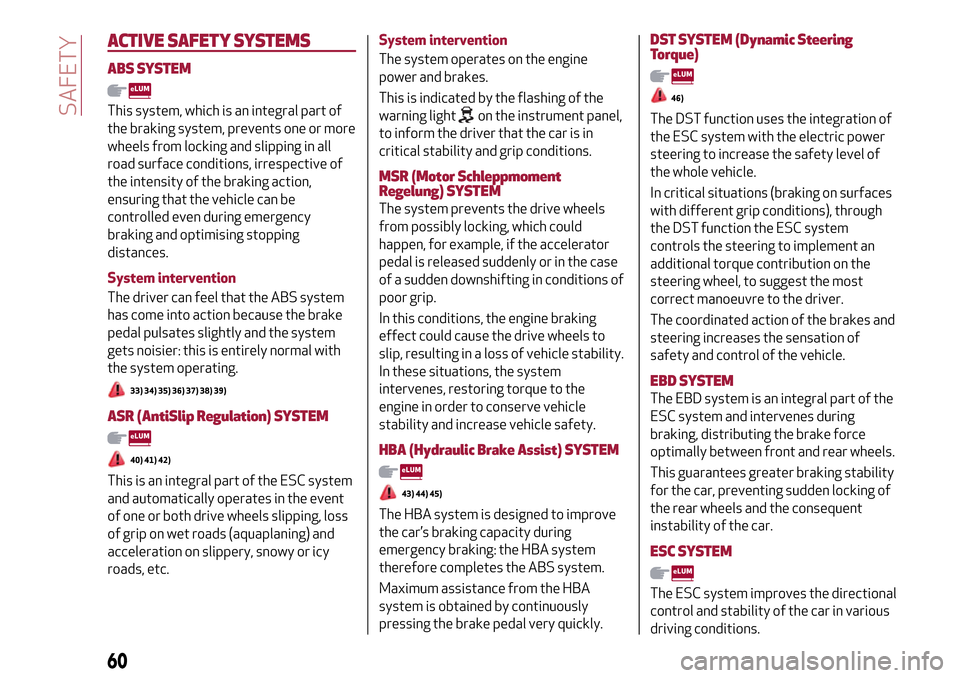
ACTIVE SAFETYSYSTEMS
ABS SYSTEM
This system, which is an integral part of
the braking system, prevents one or more
wheels from locking and slipping in all
road surface conditions, irrespective of
the intensity of the braking action,
ensuring that the vehicle can be
controlled even during emergency
braking and optimising stopping
distances.
System intervention
The driver can feel that the ABS system
has come into action because the brake
pedal pulsates slightly and the system
gets noisier: this is entirely normal with
the system operating.
33) 34) 35) 36) 37) 38) 39)
ASR (AntiSlip Regulation)SYSTEM
40) 41) 42)
This is an integral part of the ESC system
and automatically operates in the event
of one or both drive wheels slipping, loss
of grip on wet roads (aquaplaning) and
acceleration on slippery, snowy or icy
roads, etc.System intervention
The system operates on the engine
power and brakes.
This is indicated by the flashing of the
warning light
on the instrument panel,
to inform the driver that the car is in
critical stability and grip conditions.
MSR (Motor Schleppmoment
Regelung)SYSTEM
The system prevents the drive wheels
from possibly locking, which could
happen, for example, if the accelerator
pedal is released suddenly or in the case
of a sudden downshifting in conditions of
poor grip.
In this conditions, the engine braking
effect could cause the drive wheels to
slip, resulting in a loss of vehicle stability.
In these situations, the system
intervenes, restoring torque to the
engine in order to conserve vehicle
stability and increase vehicle safety.
HBA (Hydraulic Brake Assist)SYSTEM
43) 44) 45)
The HBA system is designed to improve
the car’s braking capacity during
emergency braking: the HBA system
therefore completes the ABS system.
Maximum assistance from the HBA
system is obtained by continuously
pressing the brake pedal very quickly.
DST SYSTEM (Dynamic Steering
Torque)
46)
The DST function uses the integration of
the ESC system with the electric power
steering to increase the safety level of
the whole vehicle.
In critical situations (braking on surfaces
with different grip conditions), through
the DST function the ESC system
controls the steering to implement an
additional torque contribution on the
steering wheel, to suggest the most
correct manoeuvre to the driver.
The coordinated action of the brakes and
steering increases the sensation of
safety and control of the vehicle.
EBD SYSTEM
The EBD system is an integral part of the
ESC system and intervenes during
braking, distributing the brake force
optimally between front and rear wheels.
This guarantees greater braking stability
for the car, preventing sudden locking of
the rear wheels and the consequent
instability of the car.
ESC SYSTEM
The ESC system improves the directional
control and stability of the car in various
driving conditions.
60
SAFETY
Page 63 of 212
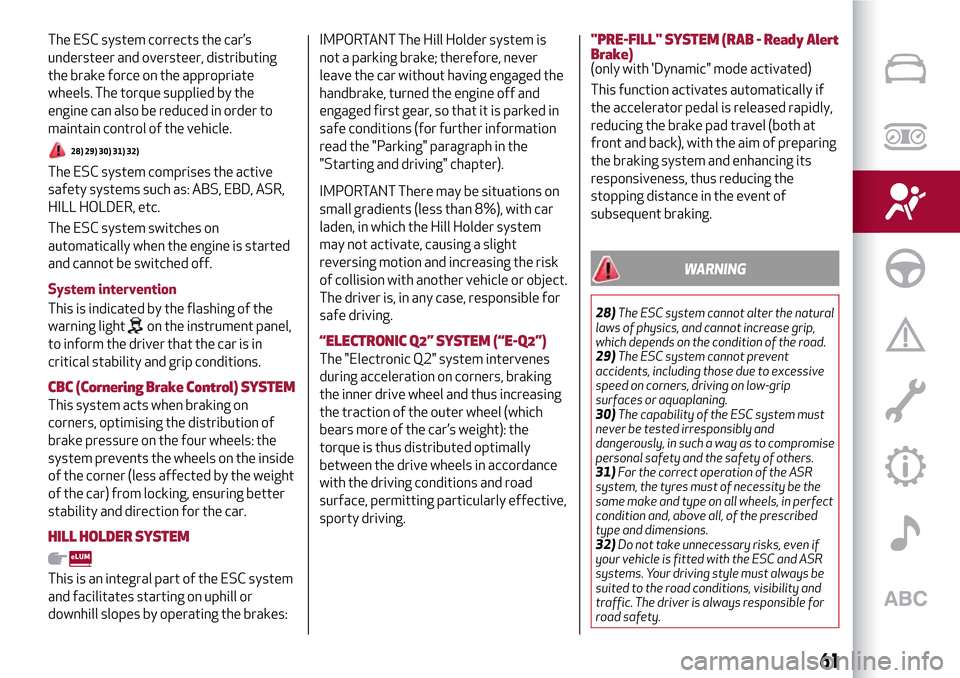
The ESC system corrects the car’s
understeer and oversteer, distributing
the brake force on the appropriate
wheels. The torque supplied by the
engine can also be reduced in order to
maintain control of the vehicle.
28) 29) 30) 31) 32)
The ESC system comprises the active
safety systems such as: ABS, EBD, ASR,
HILL HOLDER, etc.
The ESC system switches on
automatically when the engine is started
and cannot be switched off.
System intervention
This is indicated by the flashing of the
warning light
on the instrument panel,
to inform the driver that the car is in
critical stability and grip conditions.
CBC (Cornering Brake Control)SYSTEM
This system acts when braking on
corners, optimising the distribution of
brake pressure on the four wheels: the
system prevents the wheels on the inside
of the corner (less affected by the weight
of the car) from locking, ensuring better
stability and direction for the car.
HILL HOLDERSYSTEM
This is an integral part of the ESC system
and facilitates starting on uphill or
downhill slopes by operating the brakes:
IMPORTANT The Hill Holder system is
not a parking brake; therefore, never
leave the car without having engaged the
handbrake, turned the engine off and
engaged first gear, so that it is parked in
safe conditions (for further information
read the "Parking" paragraph in the
"Starting and driving" chapter).
IMPORTANT There may be situations on
small gradients (less than 8%), with car
laden, in which the Hill Holder system
may not activate, causing a slight
reversing motion and increasing the risk
of collision with another vehicle or object.
The driver is, in any case, responsible for
safe driving.
“ELECTRONIC Q2”SYSTEM (“E-Q2”)
The "Electronic Q2" system intervenes
during acceleration on corners, braking
the inner drive wheel and thus increasing
the traction of the outer wheel (which
bears more of the car’s weight): the
torque is thus distributed optimally
between the drive wheels in accordance
with the driving conditions and road
surface, permitting particularly effective,
sporty driving.
"PRE-FILL"SYSTEM (RAB - Ready Alert
Brake)
(only with 'Dynamic" mode activated)
This function activates automatically if
the accelerator pedal is released rapidly,
reducing the brake pad travel (both at
front and back), with the aim of preparing
the braking system and enhancing its
responsiveness, thus reducing the
stopping distance in the event of
subsequent braking.
WARNING
28)The ESC system cannot alter the natural
laws of physics, and cannot increase grip,
which depends on the condition of the road.
29)The ESC system cannot prevent
accidents, including those due to excessive
speed on corners, driving on low-grip
surfaces or aquaplaning.
30)The capability of the ESC system must
never be tested irresponsibly and
dangerously, in such a way as to compromise
personal safety and the safety of others.
31)For the correct operation of the ASR
system, the tyres must of necessity be the
same make and type on all wheels, in perfect
condition and, above all, of the prescribed
type and dimensions.
32)Do not take unnecessary risks, even if
your vehicle is fitted with the ESC and ASR
systems. Your driving style must always be
suited to the road conditions, visibility and
traffic. The driver is always responsible for
road safety.
61
Page 148 of 212
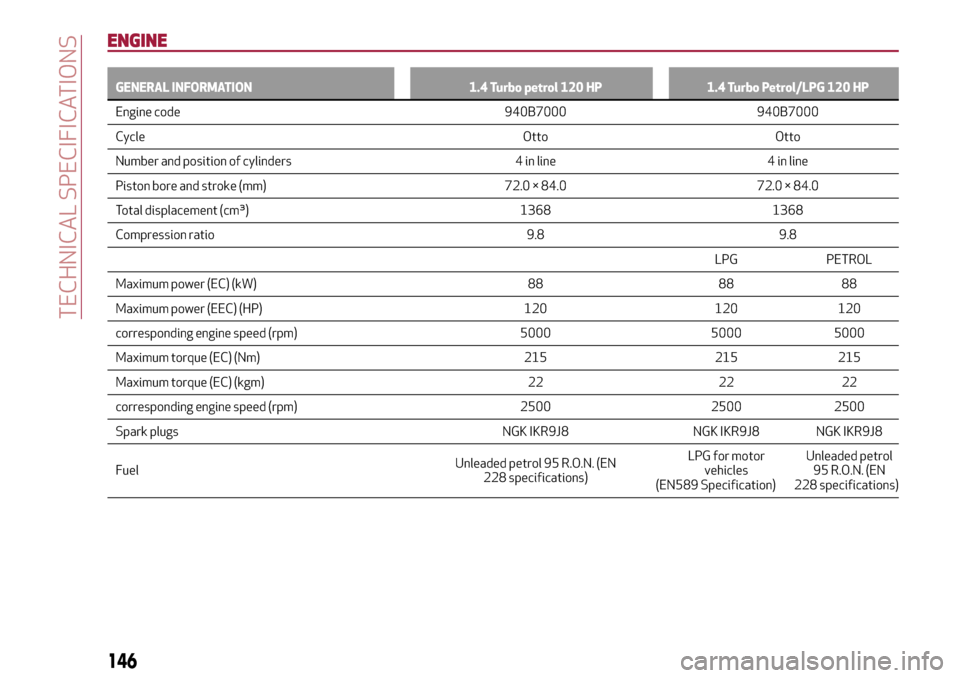
ENGINE
GENERAL INFORMATION 1.4 Turbo petrol 120 HP 1.4 Turbo Petrol/LPG 120 HP
Engine code 940B7000 940B7000
Cycle
Otto Otto
Number and position of cylinders 4 in line 4 in line
Piston bore and stroke (mm) 72.0 × 84.0 72.0 × 84.0
Total displacement (cm³) 1368 1368
Compression ratio 9.8 9.8
LPG PETROL
Maximum power (EC) (kW) 88 88 88
Maximum power (EEC) (HP) 120 120 120
corresponding engine speed (rpm) 5000 5000 5000
Maximum torque (EC) (Nm) 215 215 215
Maximum torque (EC) (kgm) 22 22 22
corresponding engine speed (rpm) 2500 2500 2500
Spark plugs NGK IKR9J8 NGK IKR9J8 NGK IKR9J8
FuelUnleaded petrol 95 R.O.N. (EN
228 specifications)LPG for motor
vehicles
(EN589 Specification)Unleaded petrol
95 R.O.N. (EN
228 specifications)
146
TECHNICAL SPECIFICATIONS
Page 149 of 212
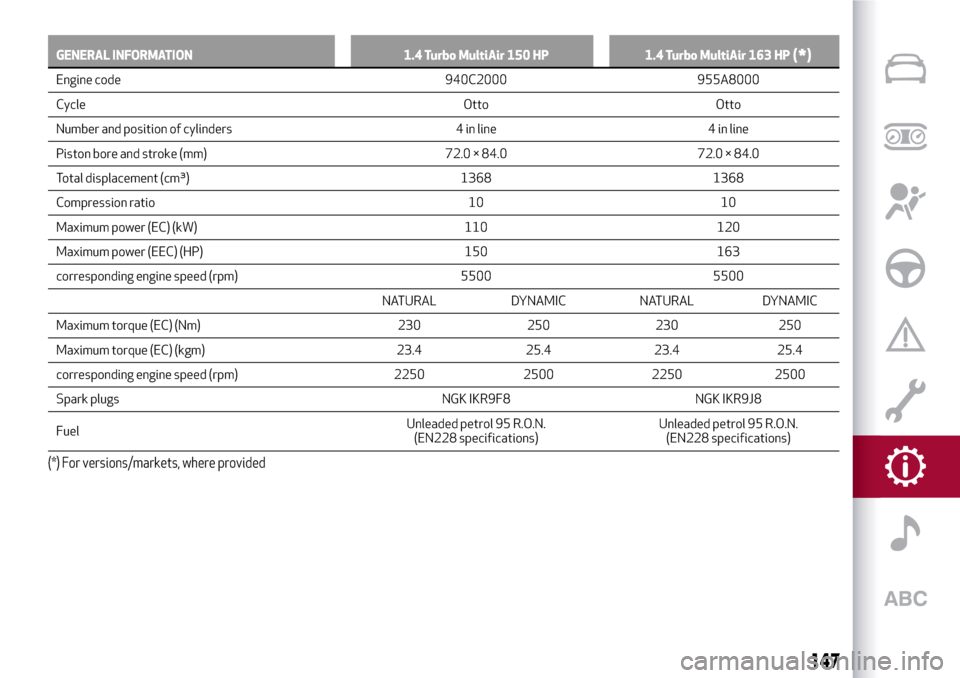
GENERAL INFORMATION 1.4 Turbo MultiAir 150 HP 1.4 Turbo MultiAir 163 HP(*)
Engine code 940C2000 955A8000
Cycle Otto Otto
Number and position of cylinders 4 in line 4 in line
Piston bore and stroke (mm) 72.0 × 84.0 72.0 × 84.0
Total displacement (cm³) 1368 1368
Compression ratio 10 10
Maximum power (EC) (kW) 110 120
Maximum power (EEC) (HP) 150 163
corresponding engine speed (rpm) 5500 5500
NATURAL DYNAMIC NATURAL DYNAMIC
Maximum torque (EC) (Nm) 230 250 230 250
Maximum torque (EC) (kgm) 23.4 25.4 23.4 25.4
corresponding engine speed (rpm) 2250 2500 2250 2500
Spark plugs NGK IKR9F8 NGK IKR9J8
FuelUnleaded petrol 95 R.O.N.
(EN228 specifications)Unleaded petrol 95 R.O.N.
(EN228 specifications)
(*) For versions/markets, where provided
147
Page 150 of 212
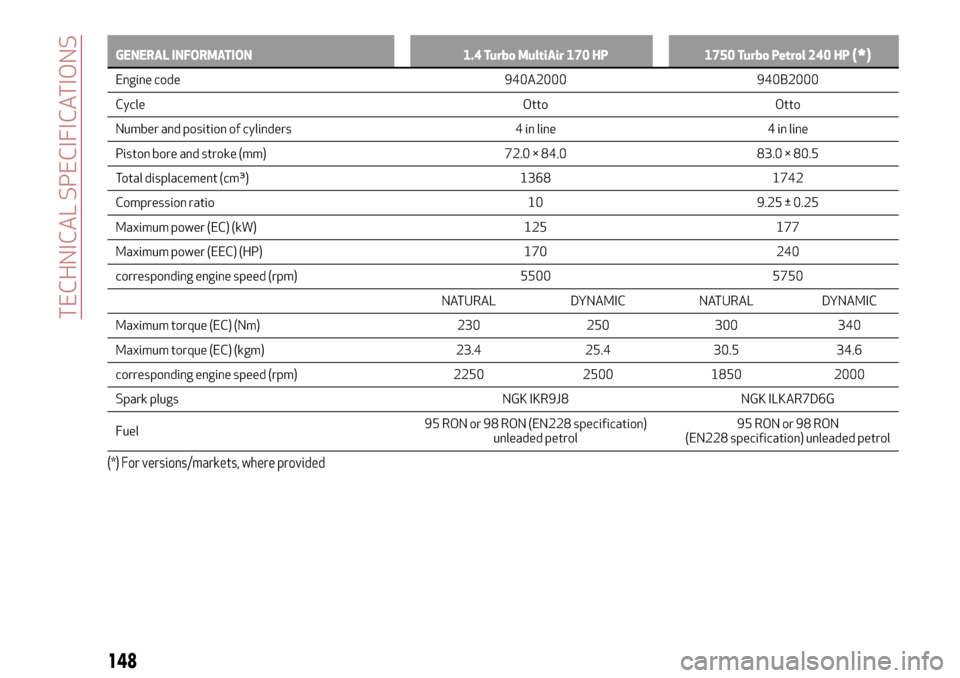
GENERAL INFORMATION 1.4 Turbo MultiAir 170 HP 1750 Turbo Petrol 240 HP(*)
Engine code 940A2000 940B2000
Cycle Otto Otto
Number and position of cylinders 4 in line 4 in line
Piston bore and stroke (mm) 72.0 × 84.0 83.0 × 80.5
Total displacement (cm³) 1368 1742
Compression ratio 10 9.25 ± 0.25
Maximum power (EC) (kW) 125 177
Maximum power (EEC) (HP) 170 240
corresponding engine speed (rpm) 5500 5750
NATURAL DYNAMIC NATURAL DYNAMIC
Maximum torque (EC) (Nm) 230 250 300 340
Maximum torque (EC) (kgm) 23.4 25.4 30.5 34.6
corresponding engine speed (rpm) 2250 2500 1850 2000
Spark plugs NGK IKR9J8 NGK ILKAR7D6G
Fuel95 RON or 98 RON (EN228 specification)
unleaded petrol95 RON or 98 RON
(EN228 specification) unleaded petrol
(*) For versions/markets, where provided
148
TECHNICAL SPECIFICATIONS
Page 151 of 212

GENERAL INFORMATION1.6 JTDM115HP(*)1.6 JTDM120 HP
Engine code 940C5000 940C1000
Cycle
Diesel Diesel
Number and position of cylinders 4 in line 4 in line
Piston bore and stroke (mm) 79.5 × 80.5 79.5 × 80.5
Total displacement (cm³) 1598 1598
Compression ratio 16.5 16.5
Maximum power (EC) (kW) 85 88
Maximum power (EEC) (HP) 115 120
corresponding engine speed (rpm) 3750 3750
NATURAL DYNAMIC NATURAL DYNAMIC
Maximum torque (EC) (Nm) 280 320 280 320
Maximum torque (EC) (kgm) 28.5 32.6 28.5 32.6
corresponding engine speed (rpm) 1500 1750 1500 1750
FuelDiesel for motor vehicles
(EN590 Specification)Diesel for motor vehicles
(EN590 Specification)
(*) For versions/markets, where provided
149
Page 152 of 212

GENERAL INFORMATION2.0 JTDM136CV2.0 JTDM150 HP
Engine code 940C4000 940C3000
Cycle
Diesel Diesel
Number and position of cylinders 4 in line 4 in line
Piston bore and stroke (mm) 83 × 90.4 83 × 90.4
Total displacement (cm³) 1956 1956
Compression ratio 16.5 16.5
NATURAL DYNAMIC
Maximum power (EC) (kW) 100 103 110
Maximum power (EEC) (HP) 136 140 150
corresponding engine speed (rpm) 4500 4000 4500
NATURAL DYNAMIC NATURAL DYNAMIC
Maximum torque (EC) (Nm) 320 380 320 380
Maximum torque (EC) (kgm) 32.5 38.7 32.5 38.7
corresponding engine speed (rpm) 1500 1750 1500 1750
FuelDiesel for motor vehicles
(EN590 Specification)Diesel for motor vehicles
(EN590 Specification)
150
TECHNICAL SPECIFICATIONS
Page 153 of 212
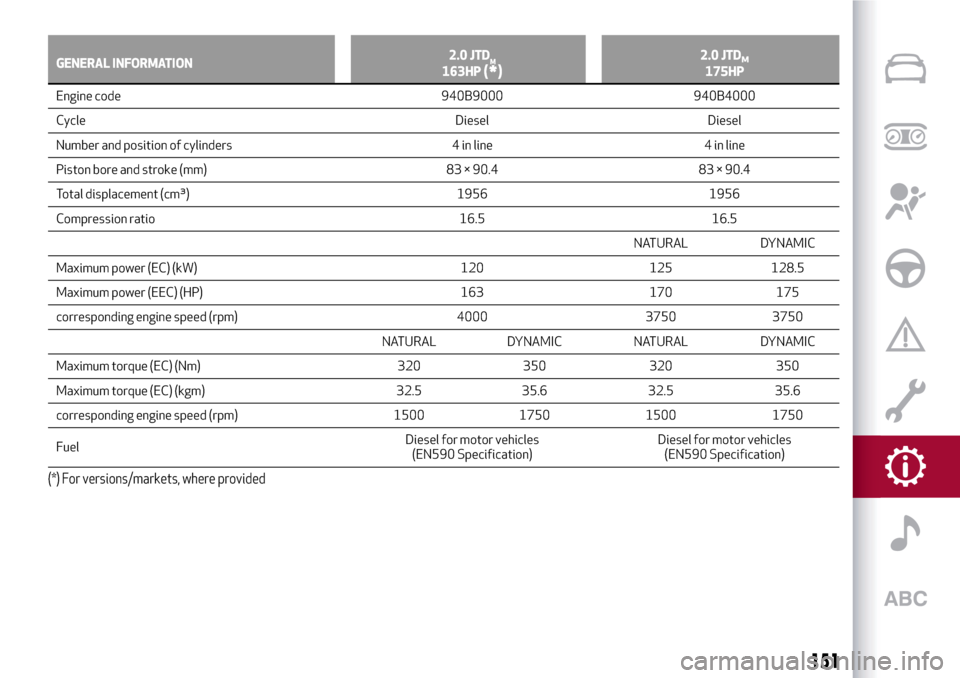
GENERAL INFORMATION2.0 JTDM163HP(*)2.0 JTDM175HP
Engine code 940B9000 940B4000
Cycle
Diesel Diesel
Number and position of cylinders 4 in line 4 in line
Piston bore and stroke (mm) 83 × 90.4 83 × 90.4
Total displacement (cm³) 1956 1956
Compression ratio 16.5 16.5
NATURAL DYNAMIC
Maximum power (EC) (kW) 120 125 128.5
Maximum power (EEC) (HP) 163 170 175
corresponding engine speed (rpm) 4000 3750 3750
NATURAL DYNAMIC NATURAL DYNAMIC
Maximum torque (EC) (Nm) 320 350 320 350
Maximum torque (EC) (kgm) 32.5 35.6 32.5 35.6
corresponding engine speed (rpm) 1500 1750 1500 1750
FuelDiesel for motor vehicles
(EN590 Specification)Diesel for motor vehicles
(EN590 Specification)
(*) For versions/markets, where provided
151
Page 207 of 212

INDEX
Alfa DNA” system.............31
ABS system................60
Active safety systems...........60
AFS adaptive lights (Adaptive
Frontlight System)...........19
Air cleaner.................137
Alarm system................11
Alfa Romeo Code system.........10
ALFATCT..................83
Key removal..............117
ASR (AntiSlip Regulation) system....60
Automatic dual-zone climate
control system.............24
AUX source.............179 ,191
Battery..................138
advice for extending its life.....138
replacement..............138
Battery (recharging)...........136
Bluetooth®..............179 ,190
Bodywork
maintenance..............140
Boot.....................30
Brakes
brake fluid level............135
Carrying children safely
.........68
CBC (Cornering Brake Control)
system..................61Changing a wheel.............110
Checking levels..............131
Cleaning and maintenance
bodywork...............140
car interior...............141
front headlights............141
leather parts..............142
leather seats..............141
plastic and coated parts.......142
seats and fabric parts........141
Climate control system..........22
CO2 emissions..............168
Control buttons...............38
Control panel and on-board
instruments...............36
Reconfigurable multifunction
display..................36
CONTROLS
Front panel control summary
table..................186
Courtesy lights
Front ceiling light............20
Cruise Control...............89
Daytime running lights (DRL)......17
Diesel filter................137
Dimensions................154
Dipped headlights
bulb replacement . .........
.100
Direction indicators............19
“Lane change” function........19bulb replacement........100 ,101
Display....................38
Doors.....................11
Child safety device...........12
Door central locking/unlocking....11
DST system (Dynamic Steering
Torque)..................60
Dusk sensor . . ...............17
EBD system................60
Electric sunroof..............27
Electric windows..............26
Controls.................26
Engine...................146
engine coolant level.........135
marking . . ...............145
Engine bonnet . . .............29
Closing..................29
Opening.................29
Engine compartment
washing . . ...............141
Engine oil
consumption..............135
level check...............135
ESC (Electronic Stability Control)
system..................60
External courtesy lights..........19
"
Electronic Q2" system ("E-Q2")
....61 "
External lights...............17